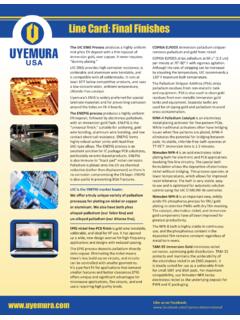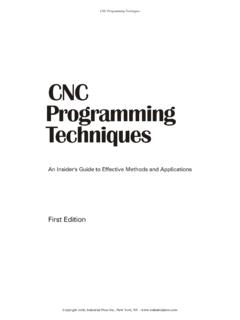Transcription of ENEPIG: Study of Suitable Palladium and Gold …
1 Study of Suitable Palladium and gold Thickness in ENEPIG Deposits for Lead Free Soldering and gold Wire Bonding Yukinori Oda, Mas ayuki Kiso, Seigo Kurosaka, Akira Okada, Kota Kitaj ima, Shigeo Hashimoto* C. Uyemura and Corporation Ltd, Central Research Laboratory, Osaka, Japan, and George Milad, Don Gudeczauskas Abstract A Study was conduct ed to det ermine the rel iability of lead free solder joints and wire bonds when ENEPIG is use d as the surface finish . Different Palladium and gold thicknesses were evaluated and their subsequent effects on the composi tion of the inter-metallic compound (IMC) and the wire bond strength were determined. Optimum thicknesess for lead free soldering and wire bonding were identified. A thickness range were both activities can be completed with high rel iability was det ermined. The IMC was studied for both and for (SAC305) solder alloys, in an attempt to explain the difference in solder joint reliability between the two lead free solders.
2 Keywords: ENEPIG, lead free solder, gold wire bonding, Intermetallic 1. Introduction Nowadays, Electroless Nickel/Immersion gold (ENIG) is commonly used for substrates that require soldering and mechanical contacting. Although ENIG with increased gold thickness (electroless gold ) is a viable finish for gold wire bonding, presently electrolytic Ni/Au is still a widely used finish for this application since concerns still remain about issues with ENIG nickel corrosion and impact resistance. However, electrolytic plating has its own challen ges in meeting today s requiremen ts of weight and form factor that require finer lines and smaller pitch. Electroless plating is a more Suitable finish for electronic parts as they continue down the path of smaller and lighter. It is already established that Electroless Nickel/ electroless Palladium / Immersion gold (ENEPIG) has excellent solderability for Sn-Ag-Cu based solders and forms high reliability wire bonds.
3 ENEPIG is becoming the choice surface finish to meet present and future market demands. In this paper, ENEPIG deposits were produced using commercially available chemicals to evaluate the reliability of lead free soldering and wire bond reliability as a function of Palladium and gold deposit thicknesses. The data will show that high reliability soldering and bonding could be achieved on the same surface with a thickness of to for Palladium and as small as for gold . Furthermore, solder joints and IMC formation for and solders with ENIG and ENEPI G were studied. The solder joints were subjected to heat treatment at 150oC for a period of 1,000 hours. Subse quent analysi s of the IMC showed that ENEPIG and ENIG showed the same IMC alloy formation with the (1), while the IMC alloys formed with solders were different for ENIG as compared to 2.
4 Test Method Two test vehicles were use d in this Study . Both were copper-clad laminate to which a 20 um thickness of electrolytic copper was plated. For the plating, commercially available plating chemicals man ufactured by C. Uyemura & CO., LTD were used. Table-1 shows this plating process. To one of the test vehicles soldermask was applied and a soldermask defined BGA patter n was developed. For IMC analysis, plating times were adjusted to produce plating deposit thicknesses of 5um of Ni, of Pd, and of Au (type F). Table-1. Ni-P/Pd/Au Plating Process etchingSPS type25 rinse10% NiNPR-480 PdTPD-3050 min.*rinceElectroless Au (F)TSB-7280 Au (A)TWX-4082 min.** : Different thickness was made by changed the dipping Au (F) : For flash (thiner) Au (A) : For Heavy (thicker) gold . UIC Technical Center, Southington, Connecticut, USAFor Study of the effects of different Pd and Au thickness, the Ni thickness was fixed at 5um.
5 The desired thicknesses of Pd and Au (type A) were then plated. Type A gold bath is capable of producing higher thicknesses of Au as compared to gold bath type F and was used for thicker gold deposits. 3. Results of Solderability Testing Table 2 is a summary of the solderabilitiy test conditions which are considered severe assembly conditions. shows the results of this testing. Table-2 Solderability Testing Conditions Solder ballSenju !FluxSenju 529D-1 RMA typeReflow instrumentTAMURA TMR-15-22 LHReflow condition5 times reflow at 260 pull instrumentDage series 4000 Ball pull speed1000"m/sec ! * thickness (um)Au thickness (um) Results of Solderability Testing Values in show a score for fracture mode after the completion of solder ball pull testing. Points were assigned to 3 types of fracture modes. For a complete fracture in the solder ball, 5 points were assigned. If the fracture interface showed <25% IMC it was assigned a point value of Finally, a fracture that showed >25% IMC at the fracture surface was assigned zero points.
6 For each test condition 20 balls were pulled and the 20 fracture surface were examined and assigned values as above. For example; if all 20 balls fractured completely in the solder with no IMC showing, each would be assigned 5 points for a total score of 100. The calculation result indicates that solderability (for these severe test conditions) in case of Palladium deposit thickness of 0 um, , ENIG is less robust compared to that if only a small thickness of Palladium is contained. However, as the Palladium deposit thickness increases, it begins to show adverse effects on the fracture mode. On the other hand increases in the gold deposit thickness (deposits up to ) do not show a similar degradation on fracture mode. If solder joint reliability is the only consideration, a Palladium deposit thickness of approximately to um and gold deposit thickness of approximately are more than adequate to achieve high reliability solder joints.
7 4. gold and Palladium Deposit Thickness and Wire Bondability In a previous paper, it was reported that ENEPIG deposits, when exposed to heat treatment could still prevent the diffusion of the underlying nickel, even in areas where the Palladium deposit is extremely thin(2). Nickel diffusion to the gold surface is a major contributor to loss of bond strength. The same test samples as those used for the solderability testing shown in were used. Heat treatment at a temperature of 175#C for a period of 16 hours was completed before conducting the wire bonding testing under the conditions shown in Table-3. Table-3 Wire Bonding Testing Conditions Wire1mil-GoldCapillaryB1014-51-18-12 (PECO)Wire bonderTPT HB16 Stage temperature150 sonic250mW(1st), 250mW(2nd)Bonding time200msec(1st), 50msec(2nd)Loading force25g(1st), 50g(2nd) (1st to 2nd wire length)Wire pull instrumentDage series 4000 Wire pull speed170"m/sec! shows the results of gold wire bond pull testing.
8 The pull test data is the result of pulling 20 wires per each condition. Values shown in are the average value of fracture strength obtained by the pull test. As the results show at a Palladium deposit thickness of 0um, no Palladium , a gold deposit thickness > is required to obtain good wire bond values. In contrast, the wire bond strength for ENEPIG was higher, even in areas with very low Palladium deposit thickness. Further increase in Palladium thickness did not improve the wire bond strength. ** thickness (um)Pd thickness (um) Results of Wire Bonding Testing! However, increasing the thickness of the gold deposit showed a marked improvement in wire bond strength. The Palladium deposit thickness was fixed at to check the effect of gold deposit thicknesses of and , respectively. Points with wire pull strength in the gold deposit thickness of and those with strength in the gold deposit thickness of were chosen, to conduct SEM observations on the secondary bond surface after the wire was pulled.
9 Shows the results of these observations. Observation on the fracture surface indicated a wide difference Au= "mAu= "mAu= "mAu= "m Difference in shape between secondary wire bond when making change to gold deposit thickness between the 2 gold thicknesses tested. Exposed underlying metal was evident in the case of the gold thickness. In contrast with the gold thickness no exposed underlying metal was evident. Since gold is a soft metal, it can be theorized that unless the gold deposit has a certain level of thickness for wire bonding, the underlying metal is scraped off to degrade the pull strength. The thicker gold deposit has a cushioning effect on the bond and produces a bond of superior strength. Insufficient gold and the possibility of nickel diffusion are the main contributors to the loss of wire bond strength. 5. Analyses of IMC Alloy Layers As can be judged even from , the solder joint formed with ENEPIG maintains a high degree of reliability under strict reflow conditions compared to that of ENIG.
10 Consequently, reflow was conducted at a temperature of 240oC as plated, and samples were also aged at 150oC for a period of 1,000 hours to simulate long-term reliability testing. In the previous paper, reliability evaluations were made on solder joints using and Sn-37Pb solders(2). In this paper, however, we made evaluations on solder joint reliabilities using solder and showed the results in Fig- 4. ENEPIG showed degradation in strength and fracture mode as heat treatment time elapses when using solder, which was the same as that shown when using Sn-37Pb solder. In addition, like the previous paper, EPMA analysis was done of the distribution of each element at bonded interfaces after 1,000 hours of heat treatment at a temperature of 150oC. It turned out as shown in , that solder showed the same Palladium aggregates that were observed with Sn-37Pb solder. In contrast when is soldered to an ENEPIG deposit, the Palladium at the IMC is uniformly distributed with no signs of aggregates.









